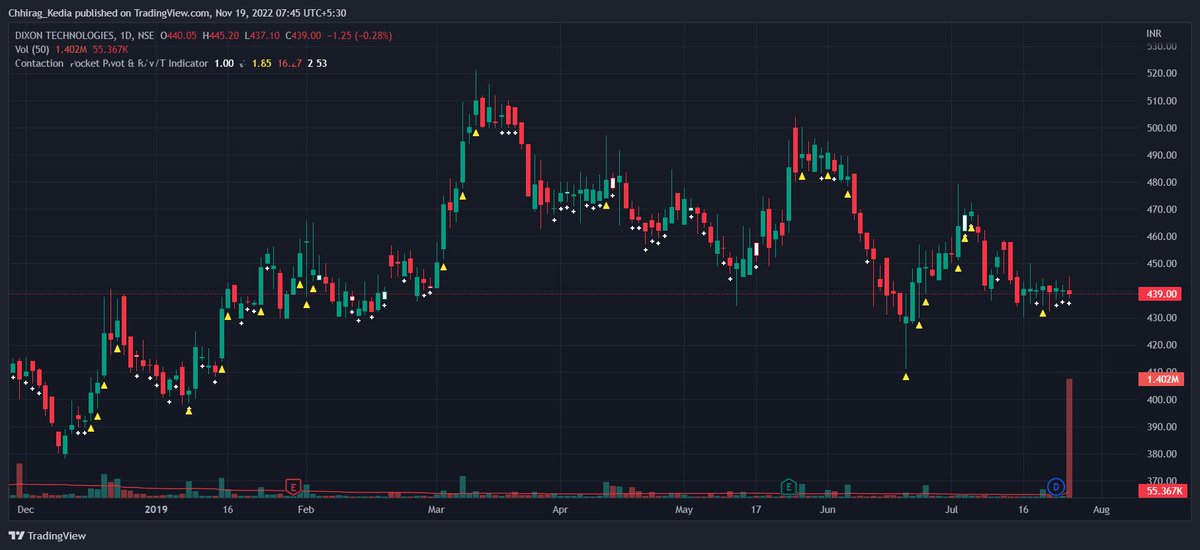
Hi Srikanth, you asked a very good and valid question. And I will love to revert on it.
First thing is, you need to understand that TA & a trading system are two different things. TA doesn't makes money, your system does.
TA just tells you that there are higher odds of (1/n)
First thing is, you need to understand that TA & a trading system are two different things. TA doesn't makes money, your system does.
TA just tells you that there are higher odds of (1/n)
https://twitter.com/mynameisnani75/status/1594022880786120704
something happening over another thing.
If you read the bible of TA - John J. Murphy's Technical Analysis of the Financial Market, you won't be able to make money from it, as it might tell you about all sort of studies that can tell about having higher odds of one outcome (2/n)
If you read the bible of TA - John J. Murphy's Technical Analysis of the Financial Market, you won't be able to make money from it, as it might tell you about all sort of studies that can tell about having higher odds of one outcome (2/n)
over another but there is much more left to be addressed to make it an implementable trading strategy.
This is the difference between a setup and strategy, which we often use interchangeably, but they are two different things. Setup is part of strategy. For example, the (3/n)
This is the difference between a setup and strategy, which we often use interchangeably, but they are two different things. Setup is part of strategy. For example, the (3/n)
#IPOBase study that I shared, it was a complete strategy with all rules to plan and manage the trade, but what people took from it was only the setup of the #IPOBase.
This is the core reason of their underperformance despite using the same setup as they lack the knowledge(4/n)
This is the core reason of their underperformance despite using the same setup as they lack the knowledge(4/n)
about the nature and potential of the strategy.
Trading is extremely funny thing, and it actually needs you to be dumb to make money. It only needs a strategy which is in sync with any market tendency, and trust on that strategy to make money.
For example, do you think (5/n)
Trading is extremely funny thing, and it actually needs you to be dumb to make money. It only needs a strategy which is in sync with any market tendency, and trust on that strategy to make money.
For example, do you think (5/n)
a idiotic sounding MA crossover can't make money? It will, overtime it definitely will - because it is in sync with the tendency of trend following. (am thankful to @PradeepBonde for teaching this concept of market tendency).
Then why we need more knowledge, why we need to (6/n)
Then why we need more knowledge, why we need to (6/n)
@PradeepBonde understand the psychology of market participants, why we need to put ourselves to so much trouble to challenge our beliefs and explore the truth.
Reason is, to eliminate the confusions and your never ending search of picture perfect patterns (which often sounds like "dhyan (7/n)
Reason is, to eliminate the confusions and your never ending search of picture perfect patterns (which often sounds like "dhyan (7/n)
se dekhiye aapke bagal mein (chart pe) khooni (3WTC) ho sakta hai"). I will explain it with an example.
@Trader_mcaruso is an USIC legend, and a genius trader. On Jun 10, 2021 he shared this tweet on $ROKU. Pay attention to the replies below. (8/n)
@Trader_mcaruso is an USIC legend, and a genius trader. On Jun 10, 2021 he shared this tweet on $ROKU. Pay attention to the replies below. (8/n)
https://twitter.com/Trader_mcaruso/status/1413590741595705346?s=20&t=DY7LDP_12kXzCi2nFBD8uw
Many renowned people like @RayTL_ and others who might have worked with WON quickly termed it a #3WTC. Someone even said that O'Neil told to go ahead and buy it on closing. Many termed it even as institutional buying.
Had they paid attention to what a #3WTC denotes, they (9/n)
Had they paid attention to what a #3WTC denotes, they (9/n)
would have known that how they are living in illusion, way away from reality. The exact reason I told that how becoming a #rulenazi is killing IBD.
A #3WTC denotes tightness. And what you see on weekly is not exclusive to daily and other LTFs. If there is a tightness in (10/n)
A #3WTC denotes tightness. And what you see on weekly is not exclusive to daily and other LTFs. If there is a tightness in (10/n)
weekly, there should be tightness in daily too. Because the underlying data is same - ticks makes minutes, minutes make hours, hours make days and days make weeks. If it is not tightened in daily, it won't be in weekly.
Sharing both charts to judge yourself weekly & daily.(11/n)

Sharing both charts to judge yourself weekly & daily.(11/n)


Is it a rule perfect #3WTC - Yes! Is it actually tightened - NO! A mere coincidence is termed as institutional accumulation by so-called gurus! Disappointing!
Hence I say I do not accept anything at its face value, regardless of from whom so ever it is coming! (12/n)
Hence I say I do not accept anything at its face value, regardless of from whom so ever it is coming! (12/n)
And this is what behavioral technical analysis will eliminate. This is why we need a change in the way TA is done!
Spend sometime this Sunday reading this and understanding what I am saying! Have a good day! (13/13)
en.wikipedia.org/wiki/Allegory_….
Spend sometime this Sunday reading this and understanding what I am saying! Have a good day! (13/13)
en.wikipedia.org/wiki/Allegory_….
• • •
Missing some Tweet in this thread? You can try to
force a refresh






